Continued from the October, 2022 issue of TAG Talk…..
What went wrong?
Coming from a climate with ‘cold’ winters, I was unaware that most Irises, like spring bulbs, actually require a winter chill in order to bloom. In the Boston areas frost is a staple of every winter, and freezing temperatures abound. Not so here in South Carolina where we might only see three to ten days of light frost in the winter, with night time temperatures average in the mid-40’s through January and February.
I found out (the hard way) that Siberian iris is generally better suited for cooler climates, and the same is true for most of the bearded irises, such as the very popular I. germanica. Gardeners, like me, in USDA Cold Hardiness Zone 9 (according to the Greenery), can have mixed results with Siberian and bearded iris. Some years the irises will bloom, but when there is an unusually warm winter it can ruin flower production the following spring.
So What’s a Girl To Do?
Make new ‘friends’ of course… Here are some of my favorite ‘substitutes’…
If you like this Grow this instead

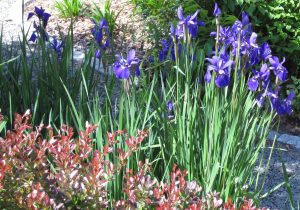
Iris Ensata ‘Variegata’
Also called the Variegated Japanese water iris. Most variegated irises have pastel colored (blue or pink) flowers but this stunning variety has deep-blue lovely flowers. This award winning iris has beautiful erect variegated foliage that is very attractive year round (evergreen). It blooms for me in a part sun exposure and I have adjusted the lawn sprinkler so that it hits this bed on its swing which gives it a relatively high amount of moisture that this Iris seems to love. This Iris is easy to grow. It blooms in Spring with a long blooming period.
Source: Monrovia/ Greenery.
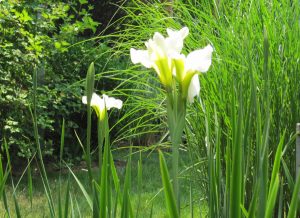

Dietes Iridioides, commonly called the African iris, comes from eastern and southern Africa. It is a rhizomatous evergreen perennials that generally resemble beardless iris and grows 2-4’ tall. This Iris is easy to grow and is planted all around the island. Unfortunately familiarity breeds contempt, and that is a pity because this iris is quite lovely.
It produces fan-shaped clumps of iris-like, narrow, sword-shaped, basal, evergreen leaves. Flowers appear on branched stalks. Each flower stalk carries a large supply of buds. Be aware NOT to cut off the stalks when a flower is spent, as it will re-bloom several times on the same stalk, if you let it.
Plants bloom spring to fall and intermittently throughout winter. Flowers last one day, but are quickly replaced. Each flower (to 3” wide) is white with yellow and blue markings. Flowering occurs in bloom bursts that often occur at 2 week intervals, hence the sometimes used common name of fortnight lily (though it is not a lily). I find it blooms quite nicely year round, especially after a rain, and it is nice to have the flowers pop up in the garden unexpectedly.
Source: Home Depot, Lowes
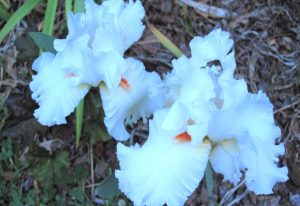
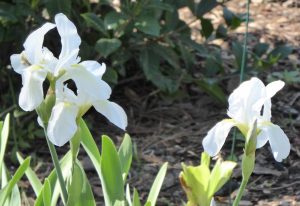
Iris Albicans
Blooming on March to early April, these Irises are indestructible! The can take scorching sun, neglect and flooding. They survive sites that often become very dry with cracked soils during the summer, but these white Iris don’t seem to mind. These are not the same as the Louisiana iris, which love the water, these prefer well drained soils. They mix well with a spring blooming verbena and other non aggressive, creeping ground covers. It grows to 12-24” tall. The leaves are grey-green, and broadly sword-shaped. The flowers are grey or silvery in bud, and are white or off-white and 3” wide in bloom. It is sterile and spreads by rhizomes.
Iris Albicans has been cultivated since ancient times and may be the oldest iris in cultivation. It has been in cultivation since at least 1400 BC.
Source: The Southern Bulb Company, www.southernbulbs.com
Here are some other Iris varieties you might also want to try…
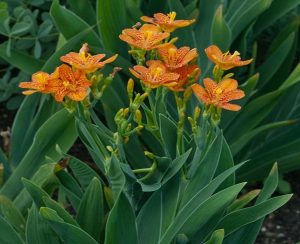
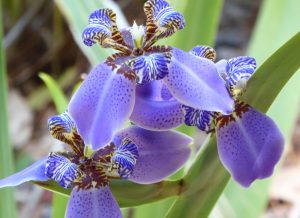
Iris Domestica
This Iris is still on my ‘wish list’. I have not grown it yet. Iris Domestica, the Blackberry Lilly is a, reportedly, easy to grow, clump forming, rhizomatous perennial with sword-shaped leaves up to 5 feet. Even when not in bloom, the foliage on these is quite striking with the leaves alternating sides up the sturdy stems. These are fast growing, drought and heat tolerant sun lovers (also happy in partial shade, especially in very hot zones). They come in a variety of colors. Aside from the orange, shown above, there is also a yellow variety called ‘Hello Yellow’, which I covet. This beautiful perennial flower not only produces lovely flowers, but perhaps also seed pods which opens to reveal what appears to be a large blackberry, but is really a cluster of bright shiny black seeds! The seedpods are excellent for flower arrangements.
Iris Regina
Iris Regina, the Queen Iris, is a vigorous growing tropical, but surprisingly cold hardy, ‘Walking’ Iris with strongly upright, architectural fans of blue-gray to green, 2-3″ wide, sword-like foliage reaching 3-5′ high. Sturdy, loose spikes of 2-3″ wide, bluish purple irises with delicately rolled, dark inky-blue veined, inner standards are born in summer, fall, winter, and spring where protected from freezing, on this highly sought after ‘blue’ Iris. (There is a white variety too). Great for containers. It has the best foliage in filtered shade in hot summer climates. It is called the ‘walking iris’ because where happy it will send of shoots that will root where they touch the ground and make a new plant, thus ‘walking’ through the garden.
You can find Iris Regina at Bruno’s, where, when in bloom, it is a customer “OMG I have to have this” kind of plant. Beware, it flies of the shelf then! It is also however sold at Home Depot, where it is simply labeled as ‘foliage plant’. If you look closer at the pot label, however, you will see it is Iris Regina. The flowers last just one day, but it produces a lot of them and they are quite lovely. Get yourself a cup of tea (or coffee), pull up a chair, and watch as the flowers slowly unfurl over the span of 4 hours.
The Regina Blue Walking Iris seems to flower best when it has developed into a well-established clump. Like most perennials this may take 2-3 growing seasons under good conditions to reach this point and it can then begin producing flowers from the mature rhizomes over an extended period during the warmer months of the year. Mine grows and blooms well in morning sun. From February through the summer, flower spikes bloom with bluish purple irises, lined with a darker blue vein. Each bloom is 3 inches to 4 inches wide and several blooms will appear on each plant. Though the individual blooms will only last a few days, this iris will bloom several times through the season.
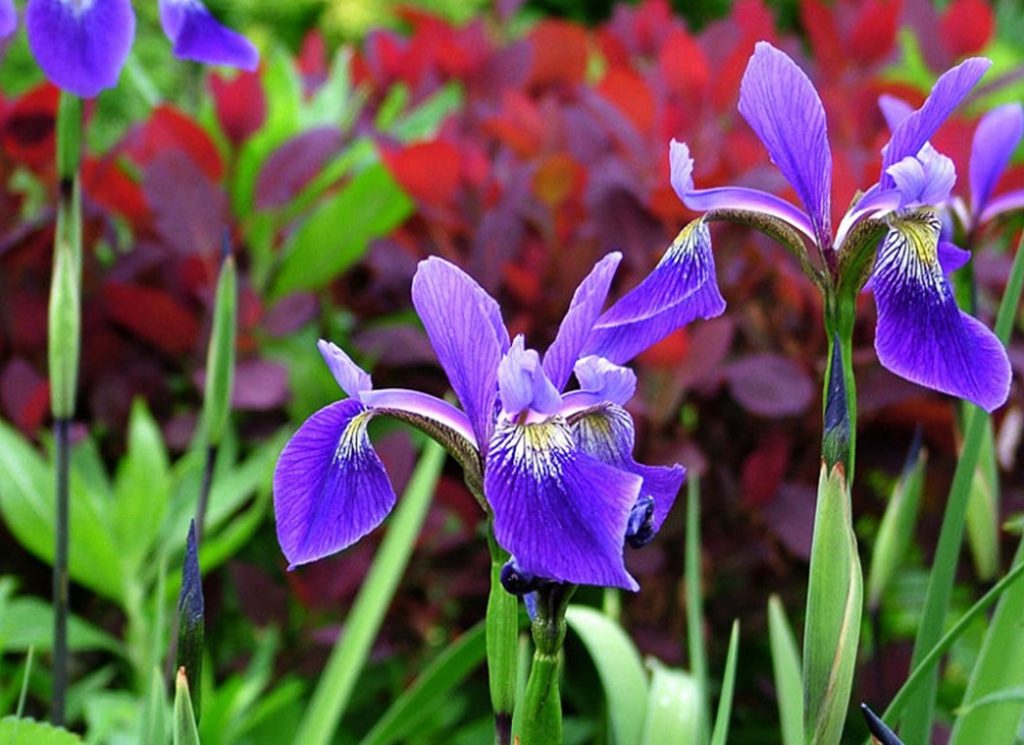
Iris Robusta
This is my latest ‘acquisition’, Iris Robusta ‘Gerald Darby’. Iris Robusta is a hybrid of two native American species: Iris Versicolor and I. Virginica.
This Iris ‘followed’ me home from Massachusetts, after a nursery woman there, warmly recommend it.
This unusual Iris can be recognized in a nursery by its distinctive purple-tinged foliage in the spring. A color that gradually fades to green in the summer. Blooms are held on deep purple stalks that can carry multiple blooms per stalk simultaneously, very unusual (for an Iris) and a lovely effect. It was recommended to me as an excellent selection for damp locations.
We will see how it does in the South.
Iris Festival
If you are interested in Iris, you might be interested in attending Sumter’s Annual Iris Festival in South Carolina. The festival is South Carolina’s oldest continuous festival and is consistently ranked among the top festivals in the Southeast. The Sumner Iris Festival is held annually on Memorial Day Weekend. The next festival is from May 25-28, 2023. (Mark your calendars). It was recommended to me by the owner of Ensata Gardens.
The 3-day festival includes concerts, arts & crafts, plants & flowers, antique & classic car shows, a number of contests and lots of children’s activities. The fun begins the evening before the festival, with the annual “Crowning of The King & Queen” followed by the “Taste at the Gardens”, featuring great music and great food from some of the area’s leading restaurants, chefs and caterers. Iris Festival | City of Sumter, SC (sumtersc.gov)
Swan Lake Iris Gardens aka ‘Bland’s Lovely Mistake’
If you do decide to go, you might also want to visit nearby Swan Lake Iris Gardens.
Legend has it that the garden was created accidentally by successful local businessman Hamilton Carr Bland. His plan was to develop the 30 acres of swamp on his property as a fishing retreat, while he was landscaping the grounds of his large home with Japanese iris (Iris ensata) a tall, regal flower whose dominant colors ranged from a light violet to a deep imperial purple.
Unfortunately for Bland, the plantings failed miserably. In an attempt to salvage his grand plan, he consulted with both local horticulturists and experts from as far afield as New York, at great expense, but to no avail. Finally, an irate Bland ordered his gardeners to dig up all the unproductive bulbs and dump them in the swamp.
Much to his amazement, the following spring those very same bulbs burst forth in full glorious bloom!
Bland might have been spared his initial dismay had even one of the horticulturists he consulted mentioned that “Oh, by the way, Iris ensata likes ‘wet feet’.” Turns out this particular flower thrives in a very damp environment, which is precisely what Bland’s bulbs had gotten when he had them tossed aside into, what he incorrectly assumed, would be a watery grave.
What began as an accidental garden has since been developed into one of the premier botanical attractions in the nation. Such was the start of, what Southern Living magazine has since then referred to as ‘Bland’s lovely mistake’, the swan lake iris gardens. A gift to the Sumter community from the Bland and Heath families, the gardens encompass 150 acres, with more than 120 varieties of iris that explode into a late-spring burst of color. Trip advisor suggest that the best time to visit the garden in the end of May. Swan Lake Iris Gardens (Sumter) – All You Need to Know BEFORE You Go (tripadvisor.com)




